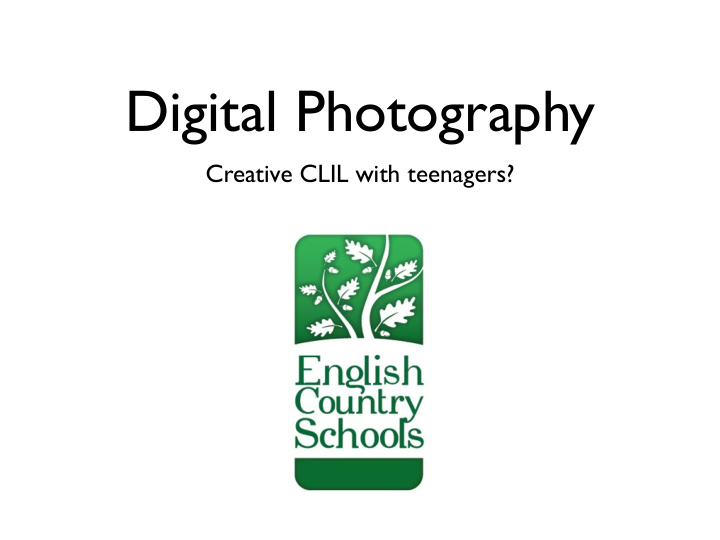



Digital Photography Creative CLIL with teenagers?
CLIL continuum
Workshop features • Photography, music, drama, video filming, creating a course journal, grammar and pronunciation, poetry, Shakespeare • Choice • Mixed age / mixed ability classes
Why workshops? • Bridge the gap between holiday and learning • Local / natural environment • But above all....
MOTIVATION
Photo workshop version 1 • Detailed teacher-led content • Presentation / practice
1.1: focus lock 1: digital camera settings 1.2: experiment on-line 9.1: experiment on-line 9: troubleshooting 2.1: eye contact 2.2: plain background 2.2.1: experiment online 8.1: Adobe on-line workshop 2.3.1: ..but know the range 8: modifying images 8.2: cropping 2.3: use flash 2.3.2: ..but also natural light periment on-line 8.3: photoIsland 2.4: move in close 2: people 7: ECS calendar 2.5.1: experiment on-line 6.1: get close 2.5: lighting 2.5.2: use fill flash 6: nature photography 2.5.3: lighting positions 6.2: assignment photo workshop 2.6.1: candid pictures 5.1: bad weather 2.6: direct !! 2.6.2: use the self-timer 5.2: trick photos 5: the unusual 5.3: angles 3.1.1: experiment on-line 3.1: move from middle 5.4: get very close-up 3.2: lighting 4.1: be ready 3.3: vertical pictures 4.2: take lots 3: landscapes 3.4: point of interest 4: action 4.3: pan 3.5: include people 4.4: get close 3.6: bad weather 4.5: zoom in 3.7: sunrise / sunset !
workshop format - Meet in the IT room - Introduce the workshop topic (eg. photographing people, photographing landscapes, etc.) - Provide black and white photocopies of the relevant part of the workshop. Read through with the students and discuss. The photographs have been printed out in colour and laminated for passing around. - Do any related ‘experiment on-line’ activities - Go out and take photographs and return and upload them to the network - Discuss the photos the students have taken and make any necessary adjustments (eg. brightness, contrast, cropping, etc) + see version 1 document
Photo workshop version 2 • Access presentation plus detailed teachers’ notes: see examples
Content - Language balance?
Content - Language balance? Please look for ways to use the photography workshop to develop and extend the students’ English. For example: Ask students to keep a photo journal o Encourage discussion of photos. For example, if the subject is people, o this provides a perfect opportunity to talk about appearance and character. If the subject is landscapes, encourage the students to describe what is in the picture. Encourage ‘critical’ discussion of the photos: what they like / don’t like o and why. How the shot could be improved. How it was taken, etc. You could organise a competition for the best photos in each category – o people, nature, movement, abstract, etc. This will certainly get the students discussing the relative merits of each photo. Encourage the students to produce photo stories (see article ‘Using o Digital Photography with Young Learners’)
Photo journal • See example (Elisa’s photography journal)
Photo story • See example here
Photo workshop • Version 3: students responsible for researching and presenting the content: landscape, portrait (people), sport, night, black and white, macro photography, top ten tips, etc.
Landscape photography
Photo workshop version 3 • Example of student presentation: night photography
Photo workshop version 3 implications Making students responsible for content: • Increases student choice / responsibility • Can be more collaborative • Can ‘Turn the classroom on its head’ • Frees the teacher to concentrate on language
Photo workshop version 3 results • Students fully engaged in learning • Creativity released: students produced more and - on average - better photos • Students used more language than previously - as a natural, integral part of the process
In conclusion • Mixed age / ability classes • High element of choice • Students responsible for content • Student to student teaching • Learning real life skills • Engaging with the real world • Fully engaged in learning
Slide show • All photos taken by students 14 - 17 during 3.5 weeks at English Country Schools, Summer 2010
Recommend
More recommend